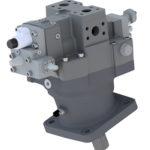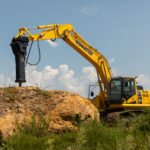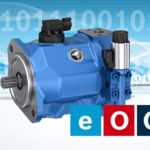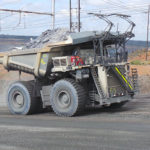Given the heightened attention on climate change and growing regulatory attempts to rein in CO2 emissions, the push toward electrification of mobile equipment is gaining momentum. Mobile OEMs are in the infancy of a major transformation toward electric-powered systems, but success in large part hinges on more-efficient fluid power systems.

| Courtesy of VolvoCE
Why does hydraulic efficiency matter? At December’s NFPA/FPIC virtual conference on Eco-Friendly Fluid Power Systems, Marty Christianson, market manager for E-Mobility at HYDAC Corp., offered a straightforward explanation by comparing conventional and e-drive machines.
In a typical machine like a wheel loader, he said, a diesel engine powers the main pump, which drives hydraulic functions such as steering, hydrostatic travel, and bucket tilt and lift. The diesel engine itself is quite inefficient, converting only about 35% of the available chemical energy in the fuel tank into mechanical energy to power the pump and other tasks. The rest is wasted as heat through the radiator or exhaust out the stack. The hydraulic system is perhaps 60% efficient due to frictional and flow losses in the pump, lines, manifolds, valves, and actuators. At the end of the day, a conventional machine is only about 12% efficient at converting energy in the tank into functional work.
In what Christianson calls Phase 1 of electrification, or the proof-of-concept stage, OEMs are removing the engine and replacing it with a single electric motor and batteries, with no change to the hydraulics. The battery and inverter have virtually no losses and the e-motor offers up to 95% efficiency. Now, with the same hydraulics, the overall machine runs about 30% efficient. But that also means much of the battery power is wasted because of less-than-optimal hydraulics.
In each case, say we upgrade the system design and components to boost hydraulic efficiency by 20% at a reasonable cost of around $5,000. On the conventional vehicle, that might save the user five gallons of fuel per day and would not be worthwhile in terms of ROI. Because the diesel engine is so inefficient, even highly efficient hydraulics plays a minor role in reducing actual energy loss of the entire system.
With an electric machine, in contrast, the hydraulics becomes very important as it accounts for almost two-thirds of the losses. The same circuit upgrade might boost overall machine efficiency from 30 to 50%, and that brings several very tangible benefits.
One is longer intervals between battery recharges. Equipment can operate for extended periods between charges with higher overall output, offering a significant competitive advantage. Then there’s battery cost. Wasting energy on a less-efficient system, in turn, requires a bigger battery for the same performance. Larger battery packs will add tens of thousands of dollars in upfront costs. And outsized batteries weigh a lot more, which means a lower load capacity and lower productivity.
So it becomes critically important to examine hydraulic efficiency on an electric machine, particularly as OEMs look beyond Phase 1 to more advanced electrified architectures where the efficiency of every function will be scrutinized.
Forward-looking equipment builders are focused on energy-efficient hydraulic components and systems, as they have a direct impact on the type and size of batteries and motors. Ideas abound, from variable speed motor-pump drives that only run on demand, common-rail and decentralized systems, and valveless circuits to high-VI fluid additives, low ΔP filters and 3D printed manifolds with optimal flow paths. In the end, successful development of extremely efficient hydraulics will enable the requisite e-machine performance that customers demand. Otherwise, electromechanical alternatives will eventually win the day.






